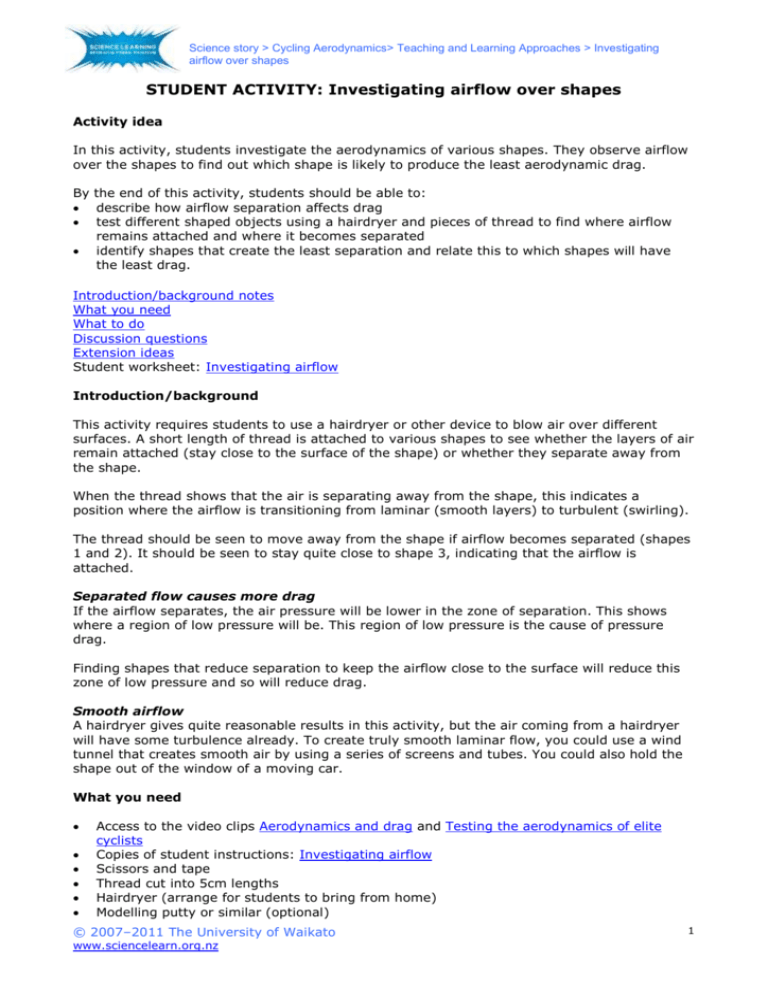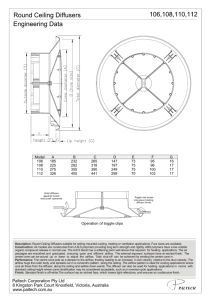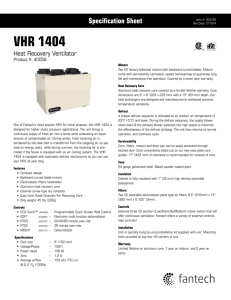Investigating air flow over shapes
advertisement

Science story > Cycling Aerodynamics> Teaching and Learning Approaches > Investigating airflow over shapes STUDENT ACTIVITY: Investigating airflow over shapes Activity idea In this activity, students investigate the aerodynamics of various shapes. They observe airflow over the shapes to find out which shape is likely to produce the least aerodynamic drag. By the end of this activity, students should be able to: describe how airflow separation affects drag test different shaped objects using a hairdryer and pieces of thread to find where airflow remains attached and where it becomes separated identify shapes that create the least separation and relate this to which shapes will have the least drag. Introduction/background notes What you need What to do Discussion questions Extension ideas Student worksheet: Investigating airflow Introduction/background This activity requires students to use a hairdryer or other device to blow air over different surfaces. A short length of thread is attached to various shapes to see whether the layers of air remain attached (stay close to the surface of the shape) or whether they separate away from the shape. When the thread shows that the air is separating away from the shape, this indicates a position where the airflow is transitioning from laminar (smooth layers) to turbulent (swirling). The thread should be seen to move away from the shape if airflow becomes separated (shapes 1 and 2). It should be seen to stay quite close to shape 3, indicating that the airflow is attached. Separated flow causes more drag If the airflow separates, the air pressure will be lower in the zone of separation. This shows where a region of low pressure will be. This region of low pressure is the cause of pressure drag. Finding shapes that reduce separation to keep the airflow close to the surface will reduce this zone of low pressure and so will reduce drag. Smooth airflow A hairdryer gives quite reasonable results in this activity, but the air coming from a hairdryer will have some turbulence already. To create truly smooth laminar flow, you could use a wind tunnel that creates smooth air by using a series of screens and tubes. You could also hold the shape out of the window of a moving car. What you need Access to the video clips Aerodynamics and drag and Testing the aerodynamics of elite cyclists Copies of student instructions: Investigating airflow Scissors and tape Thread cut into 5cm lengths Hairdryer (arrange for students to bring from home) Modelling putty or similar (optional) © 2007–2011 The University of Waikato www.sciencelearn.org.nz 1 Science story > Cycling Aerodynamics> Teaching and Learning Approaches > Investigating airflow over shapes What to do 1. Introduce the purpose of the activity – to find out what the most aerodynamic shapes are. 2. Brainstorm in pairs or small groups: What shapes/objects/vehicles are well streamlined with not much drag? What shapes/objects/vehicles are not well streamlined and have a lot of drag? What parts of a cyclist cause the most drag? Why? What can be done to make a cyclist more aerodynamic? 3. Watch the video clip Aerodynamics and drag. Discuss/record the two types of drag relevant for cyclists. 4. Watch the video clip Testing the aerodynamics of elite cyclists. Discuss what methods are used to observe the drag of cyclists. What methods could be used for today’s challenge? 5. Hand out copies of the student worksheet Investigating airflow and discuss. 6. Discuss the results once students have completed the activity. Discussion questions What shapes cause the airflow to separate from the surface the most? What shapes cause the airflow to separate from the surface the least? What things can a cyclist do to reduce the drag caused by this separation of airflow? Extension ideas Investigate how air flows around a cylinder using lengths of thread and a hairdryer. Use paper or modelling putty or similar to turn the cylinder into an aerofoil shape. How is the airflow affected? Tape some lengths of thread to a bike helmet to observe airflow using a hairdryer. How might the helmet be modified to reduce drag? Tape some lengths of thread to different parts of a bike frame to observe direction of airflow over the frame as you are biking along or using a hairdryer to direct air over it. Tape some lengths of thread to the edge of your car wing mirror and also to the windscreen. As the speed of the car increases, observe to see whether the airflow is separated and turbulent (swirling) or attached and laminar (smooth). Identify the parts on your car that create the most drag due to turbulence. Research how a wind tunnel produces fast laminar airflow. Build your own wind tunnel. Try to work out a way of measuring the drag acting, perhaps with the use of electronic scales or with small masses on a string and pulley. © 2007–2011 The University of Waikato www.sciencelearn.org.nz 2 Science story > Cycling Aerodynamics> Teaching and Learning Approaches > Investigating airflow over shapes Investigating airflow 1. Use the template provided to cut out shapes 1–3, fold them and tape them together as shown. Which shape is likely to have the least aerodynamic drag? 2. Tape a small piece of thread to each shape and use a hairdryer to direct air over the shape as shown in the left-hand column below. 3. Observe the thread to see whether the airflow remains attached close to the shape or whether it separates. 4. In the right-hand column, use a pencil to shade the areas that will have low air pressure due to airflow separation. Test each shape as shown below Shape 1a Shade the areas of low pressure Air flow Shape 1b Air flow Shape 2 Air flow Shape 3 Air flow 5. Try using a tuft wand – a small length of thread attached to a narrow rod such as a pencil to observe the direction of airflow at different positions and at different distances away from the shape. © 2007–2011 The University of Waikato www.sciencelearn.org.nz 3 Science story > Cycling Aerodynamics> Teaching and Learning Approaches > Investigating airflow over shapes Shape 1 © 2007–2011 The University of Waikato www.sciencelearn.org.nz 4 Science story > Cycling Aerodynamics> Teaching and Learning Approaches > Investigating airflow over shapes Shape 2 © 2007–2011 The University of Waikato www.sciencelearn.org.nz 5 Science story > Cycling Aerodynamics> Teaching and Learning Approaches > Investigating airflow over shapes Shape 3 © 2007–2011 The University of Waikato www.sciencelearn.org.nz 6







